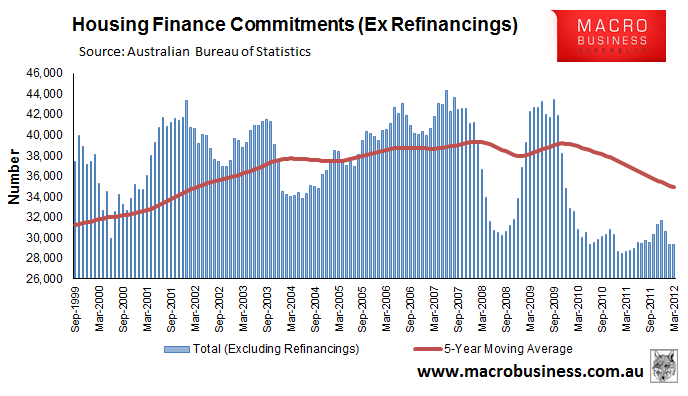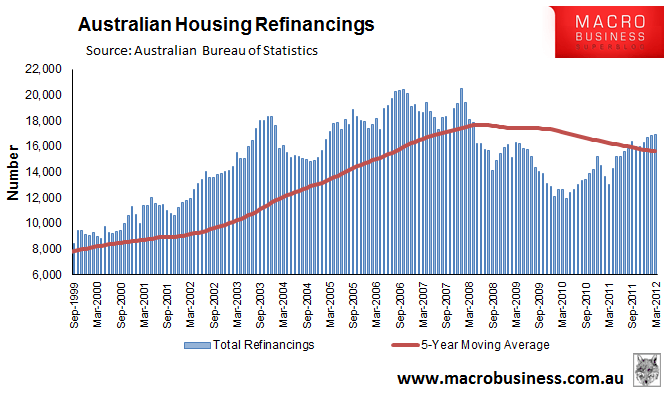
From Property Observer today comes news that the 50 basis point cut in official interest rates in May, of which around 35 basis points was passed onto borrowers, has failed to stimulate mortgage demand:
The Reserve Bank has presented the carrot, but few borrowers appear to be biting, according to mortgage enquiry figures from mortgage broker Loan Market.
Loan Market, part of the Ray White Group, has recorded only a 5% increase in loan enquiries to date in May compared with April.
The Loan Market update follows mortgage comparison website Ratecity.com.au noting that the biggest change in borrower behaviour of late has been an increase in refinancing activity, with 18,000 borrowers refinancing their home loans in March – the highest number of refinanced home loans in one month since April 2008.
Certainly, the latest Australian Bureau of Statistics (ABS) housing finance data for March, which pre-dates the latest cut in interest rates, shows that new mortgage demand is anaemic, with the number of finance commitments (excluding refinancings) tracking near decade lows and some -16% below the 5-year moving average (5YMA):

In fact, as outlined in the article, the only segment where mortgage demand appears to be booming is refinancings, which typically do not represent a lift in the demand for housing, and will have negligible direct impact on the overall level of economic activity. According to the ABS, refinancings have been in a strong uptrend since early 2010 and were tracking around 8% above their 5-year moving average in March 2012:

As expected, Loan Market is calling on the RBA to cut interest rates further in order to stimulate mortgage demand, consumer confidence, and spending:
Loan Market says the underwhelming response from consumers to date means further stimulus is needed.
“The RBA’s 50-basis-points rate reduction was an essential starting point and with most banks passing on a significant amount of the rate cut, mortgage holders have been able to start better combat the rising cost of living,” says Loan Market corporate spokesman Paul Smith.
“But it looks as if more reductions from the RBA will be needed to make a real impact on the economy, especially in housing and retail.”
“With the situation in Europe deteriorating over the past few weeks again, fresh concerns over the domestic impact of a eurozone collapse will keep consumer confidence reserved and subdued.”
“The RBA has room to take the cash rate down significantly, and we expect to see the official rate lowered again at the central bank’s June meeting,” he says.
However, Loan Market then inadvertently questions whether demand would in fact be stimulated by further interest rate cuts, since most consumers would likely use the proceeds to boost loan repayments and/or savings:
A recent Loan Market online poll found almost 80% of consumers were using the benefits from the May rate cut to boost their home loan repayments or increase savings.
Only 2% of respondents were planning to spend the extra cash resulting from the interest rate reduction.
The Loan Market poll referred to above is supported by the release last week of the Boston Consulting Group’s (BCG) consumer sentiment survey, which found that household’s desire to save is entrenched:
Australians were now also hooked on savings, Mr Goth said. ”Even if the economy turned around 90 per cent, they said they would still save more money, they are not going to change that habit,” he said.
This showed up in the survey, with 50 per cent of Australians saying they intended to spend less on discretionary items.
As shown by Houses and Holes yesterday, the RBA is now limited in its ability to lower mortgage rates, with the prospect of sub-5% mortgages appearing increasingly unlikely. And even if the RBA does slash mortgage rates down to this level, it is uncertain whether Australian households would take the bait, gear-up and spend, or would instead choose to use the proceeds to pay down debt and save.
The Paradox of Thrift appears set to continue putting a break on debt-dependent sectors of the Australian economy.

